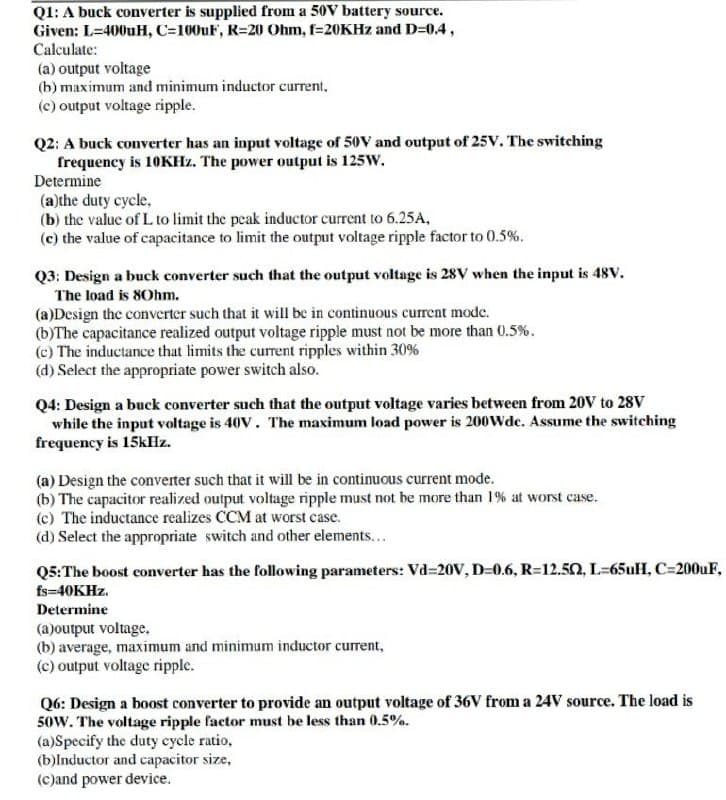Q1: A buck converter is supplied from a 50V battery source. Given: L=400uH, C=100UF, R=20 Ohm, f=20KHZ and D=0.4, Calculate: (a) output voltage (b) maximum and minimum inductor current, (c) output voltage ripple.
Q1: A buck converter is supplied from a 50V battery source. Given: L=400uH, C=100UF, R=20 Ohm, f=20KHZ and D=0.4, Calculate: (a) output voltage (b) maximum and minimum inductor current, (c) output voltage ripple.
Introductory Circuit Analysis (13th Edition)
13th Edition
ISBN:9780133923605
Author:Robert L. Boylestad
Publisher:Robert L. Boylestad
Chapter1: Introduction
Section: Chapter Questions
Problem 1P: Visit your local library (at school or home) and describe the extent to which it provides literature...
Related questions
Question

Transcribed Image Text:Q1: A buck converter is supplied from a 50V battery source.
Given: L=400uH, C=100uF, R=20 Ohm, f=20KHZ and D=0.4,
Calculate:
(a) output voltage
(b) maximum and minimum inductor current,
(c) output voltage ripple.
Q2: A buck converter has an input voltage of 50V and output of 25V. The switching
frequency is 10KHZ. The power output is 125W.
Determine
(a)the duty cycle,
(b) the value of L to limit the peak inductor current to 6.25A,
(c) the value of capacitance to limit the output voltage ripple factor to 0.5%.
Q3: Design a buck converter such that the output voltage is 28V when the input is 48v.
The load is 80hm.
(a)Design the converter such that it will be in continuous current mode.
(b)The capacitance realized output voltage ripple must not be more than 0.5%.
(c) The inductance that limits the current ripples within 30%
(d) Select the appropriate power switch also.
Q4: Design a buck converter such that the output voltage varies between from 20V to 28V
while the input voltage is 40V. The maximum load power is 200Wde. Assume the switching
frequency is 15kHz.
(a) Design the converter such that it will be in continuous current mode.
(b) The capacitor realized output voltage ripple must not be more than 1% at worst case.
(c) The inductance realizes CCM at worst case.
(d) Select the appropriate switch and other elements...
Q5:The boost converter has the following parameters: Vd=20V, D=0.6, R=12.50, L=65uH, C=200UF,
fs=40KHZ.
Determine
(a)output voltage,
(b) average, maximum and minimum inductor current,
(c) output voltage ripple.
Q6: Design a boost converter to provide an output voltage of 36V from a 24V source. The load is
50w. The voltage ripple factor must be less than 0.5%.
(a)Specify the duty cycle ratio,
(b)lnductor and capacitor size,
(c)and power device.
Expert Solution
This question has been solved!
Explore an expertly crafted, step-by-step solution for a thorough understanding of key concepts.
This is a popular solution!
Trending now
This is a popular solution!
Step by step
Solved in 2 steps with 1 images

Knowledge Booster
Learn more about
Need a deep-dive on the concept behind this application? Look no further. Learn more about this topic, electrical-engineering and related others by exploring similar questions and additional content below.Recommended textbooks for you

Introductory Circuit Analysis (13th Edition)
Electrical Engineering
ISBN:
9780133923605
Author:
Robert L. Boylestad
Publisher:
PEARSON

Delmar's Standard Textbook Of Electricity
Electrical Engineering
ISBN:
9781337900348
Author:
Stephen L. Herman
Publisher:
Cengage Learning

Programmable Logic Controllers
Electrical Engineering
ISBN:
9780073373843
Author:
Frank D. Petruzella
Publisher:
McGraw-Hill Education

Introductory Circuit Analysis (13th Edition)
Electrical Engineering
ISBN:
9780133923605
Author:
Robert L. Boylestad
Publisher:
PEARSON

Delmar's Standard Textbook Of Electricity
Electrical Engineering
ISBN:
9781337900348
Author:
Stephen L. Herman
Publisher:
Cengage Learning

Programmable Logic Controllers
Electrical Engineering
ISBN:
9780073373843
Author:
Frank D. Petruzella
Publisher:
McGraw-Hill Education

Fundamentals of Electric Circuits
Electrical Engineering
ISBN:
9780078028229
Author:
Charles K Alexander, Matthew Sadiku
Publisher:
McGraw-Hill Education

Electric Circuits. (11th Edition)
Electrical Engineering
ISBN:
9780134746968
Author:
James W. Nilsson, Susan Riedel
Publisher:
PEARSON

Engineering Electromagnetics
Electrical Engineering
ISBN:
9780078028151
Author:
Hayt, William H. (william Hart), Jr, BUCK, John A.
Publisher:
Mcgraw-hill Education,